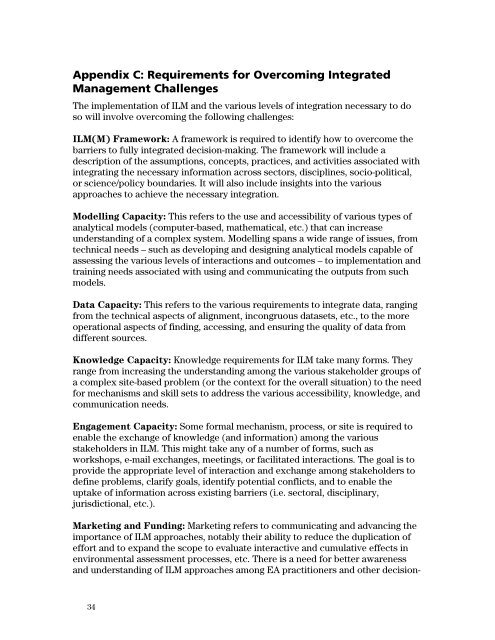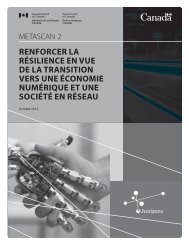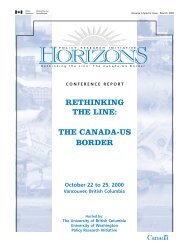PDF Format
PDF Format
PDF Format
Create successful ePaper yourself
Turn your PDF publications into a flip-book with our unique Google optimized e-Paper software.
Appendix C: Requirements for Overcoming Integrated<br />
Management Challenges<br />
The implementation of ILM and the various levels of integration necessary to do<br />
so will involve overcoming the following challenges:<br />
ILM(M) Framework: A framework is required to identify how to overcome the<br />
barriers to fully integrated decision-making. The framework will include a<br />
description of the assumptions, concepts, practices, and activities associated with<br />
integrating the necessary information across sectors, disciplines, socio-political,<br />
or science/policy boundaries. It will also include insights into the various<br />
approaches to achieve the necessary integration.<br />
Modelling Capacity: This refers to the use and accessibility of various types of<br />
analytical models (computer-based, mathematical, etc.) that can increase<br />
understanding of a complex system. Modelling spans a wide range of issues, from<br />
technical needs – such as developing and designing analytical models capable of<br />
assessing the various levels of interactions and outcomes – to implementation and<br />
training needs associated with using and communicating the outputs from such<br />
models.<br />
Data Capacity: This refers to the various requirements to integrate data, ranging<br />
from the technical aspects of alignment, incongruous datasets, etc., to the more<br />
operational aspects of finding, accessing, and ensuring the quality of data from<br />
different sources.<br />
Knowledge Capacity: Knowledge requirements for ILM take many forms. They<br />
range from increasing the understanding among the various stakeholder groups of<br />
a complex site-based problem (or the context for the overall situation) to the need<br />
for mechanisms and skill sets to address the various accessibility, knowledge, and<br />
communication needs.<br />
Engagement Capacity: Some formal mechanism, process, or site is required to<br />
enable the exchange of knowledge (and information) among the various<br />
stakeholders in ILM. This might take any of a number of forms, such as<br />
workshops, e-mail exchanges, meetings, or facilitated interactions. The goal is to<br />
provide the appropriate level of interaction and exchange among stakeholders to<br />
define problems, clarify goals, identify potential conflicts, and to enable the<br />
uptake of information across existing barriers (i.e. sectoral, disciplinary,<br />
jurisdictional, etc.).<br />
Marketing and Funding: Marketing refers to communicating and advancing the<br />
importance of ILM approaches, notably their ability to reduce the duplication of<br />
effort and to expand the scope to evaluate interactive and cumulative effects in<br />
environmental assessment processes, etc. There is a need for better awareness<br />
and understanding of ILM approaches among EA practitioners and other decision-<br />
34











